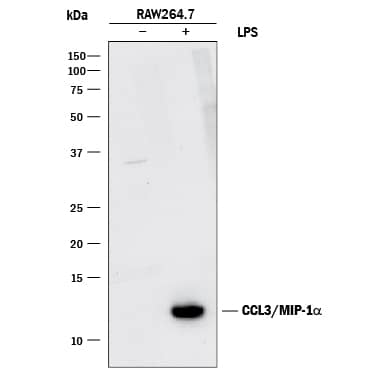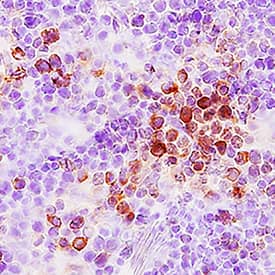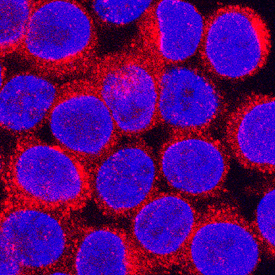Mouse CCL3/MIP-1 alpha Antibody
R&D Systems, part of Bio-Techne | Catalog # AF-450-NA


Key Product Details
Validated by
Species Reactivity
Validated:
Cited:
Applications
Validated:
Cited:
Label
Antibody Source
Product Specifications
Immunogen
Ala24-Ala92
Accession # Q5QNW0
Specificity
Clonality
Host
Isotype
Endotoxin Level
Scientific Data Images for Mouse CCL3/MIP-1 alpha Antibody
Detection of Mouse CCL3/MIP‑1 alpha by Western Blot.
Western blot shows lysates of RAW 264.7 mouse monocyte/macrophage cell line untreated (-) or treated (+) with 10 µg/mL LPS for 4 hours. PVDF membrane was probed with 1 µg/mL of Goat Anti-Mouse CCL3/MIP-1a Antigen Affinity-purified Polyclonal Antibody (Catalog # AF-450-NA) followed by HRP-conjugated Anti-Goat IgG Secondary Antibody (Catalog # HAF017). A specific band was detected for CCL3/MIP-1a at approximately 12 kDa (as indicated). This experiment was conducted under reducing conditions and using Immunoblot Buffer Group 1.CCL3/MIP‑1 alpha in Mouse Thymus.
CCL3/MIP-1a was detected in perfusion fixed frozen sections of mouse thymus using Goat Anti-Mouse CCL3/MIP-1a Antigen Affinity-purified Polyclonal Antibody (Catalog # AF-450-NA) at 15 µg/mL overnight at 4 °C. Tissue was stained using the Anti-Goat HRP-DAB Cell & Tissue Staining Kit (brown; Catalog # CTS008) and counterstained with hematoxylin (blue). Specific staining was localized to cytoplasm. View our protocol for Chromogenic IHC Staining of Frozen Tissue Sections.CCL3/MIP‑1 alpha in RAW 264.7 Mouse Cell Line.
CCL3/MIP-1a was detected in immersion fixed RAW 264.7 mouse monocyte/macrophage cell line using Goat Anti-Mouse CCL3/MIP-1a Antigen Affinity-purified Polyclonal Antibody (Catalog # AF-450-NA) at 5 µg/mL for 3 hours at room temperature. Cells were stained using the NorthernLights™ 557-conjugated Anti-Goat IgG Secondary Antibody (red; Catalog # NL001) and counterstained with DAPI (blue). Specific staining was localized to cytoplasm. View our protocol for Fluorescent ICC Staining of Cells on Coverslips.Applications for Mouse CCL3/MIP-1 alpha Antibody
Immunocytochemistry
Sample: Immersion fixed RAW264.7 mouse monocyte/macrophage cell line
Immunohistochemistry
Sample: Perfusion fixed frozen sections of mouse small intestine (Peyer's patch) and mouse thymus
Western Blot
Sample: RAW 264.7 mouse monocyte/macrophage cell line treated with LPS
Neutralization
Mouse CCL3/MIP-1 alpha Sandwich Immunoassay
Reviewed Applications
Read 3 reviews rated 4.3 using AF-450-NA in the following applications:
Formulation, Preparation, and Storage
Purification
Reconstitution
Formulation
Shipping
Stability & Storage
- 12 months from date of receipt, -20 to -70 °C as supplied.
- 1 month, 2 to 8 °C under sterile conditions after reconstitution.
- 6 months, -20 to -70 °C under sterile conditions after reconstitution.
Background: CCL3/MIP-1 alpha
The macrophage inflammatory proteins 1 alpha and 1 beta, two closely related but distinct proteins, were originally co-purified from medium conditioned by a LPS-stimulated murine macrophage cell line. Mature mouse MIP-1 alpha shares approximately 77% and 70% amino acid identity with human MIP-1 alpha and mouse MIP-1 beta, respectively. MIP‑1 proteins are expressed primarily in T cells, B cells, and monocytes after antigen or mitogen stimulation. The MIP-1 proteins are members of the beta (C-C) subfamily of chemokines.
Both MIP-1 alpha and MIP-1 beta are monocyte chemoattractants in vitro. Additionally, the MIP-1 proteins have been reported to have chemoattractant and adhesive effects on lymphocytes, with MIP-1 alpha and MIP-1 beta preferentially attracting CD8+ and CD4+ T cells, respectively. MIP-1 alpha has also been shown to attract B cells as well as eosinophils. MIP-1 proteins have been reported to have multiple effects on hematopoietic precursor cells and MIP-1 alpha has been identified as a stem cell inhibitory factor that can inhibit the proliferation of hematopoietic stem cells in vitro as well as in vivo. In the same assays, MIP-1 beta was reported to be much less active. The functional receptor for MIP-1 alpha has been identified as CCR1 and CCR5.
References
- Menten, P. et al. (2002) Cytokine Growth Factor Rev. 13:455.
Alternate Names
Entrez Gene IDs
Gene Symbol
UniProt
Additional CCL3/MIP-1 alpha Products
Product Documents for Mouse CCL3/MIP-1 alpha Antibody
Product Specific Notices for Mouse CCL3/MIP-1 alpha Antibody
For research use only


